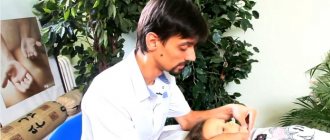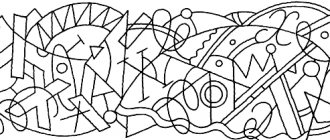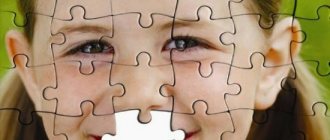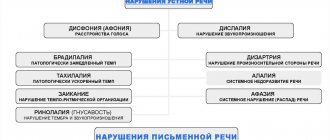general information
With dysarthria, the functioning of the motor nerves is disrupted. Because of this, the child’s speech is difficult to switch between sounds, it is difficult to understand and sounds blurry. There may be problems with breathing and intonation.
The defect is always based on problems with the nervous system. Most often they occur as a result of unfavorable pregnancy and childbirth. A slight lack of oxygen negatively affects brain function.
In the first year of life, the child’s body is very sensitive to various types of infections and injuries. Any such exposure can lead to the death of nerve cells and the development of pathologies.
Most often, dysarthria accompanies cerebral palsy. But its mild forms are also observed in preschoolers without these pathologies. Manifestations of the defect can have varying degrees of severity.
The peculiarity of this disorder is that the preschooler does not feel the muscles of the oral cavity - neither tension nor relaxation. This is what makes it difficult for organs to switch from one sound to another sound.
Difficulties may arise in forming a connection between the movements of the organs of articulation and the heard sound. Children have motor skills problems and are often clumsy and awkward.
Symptoms of the disease
The symptoms of pseudobulbar dysarthria depend on the severity, of which there are only four:
- 1st degree – there are no pronounced speech defects, which can be identified by a speech therapist.
- 2nd degree – the child’s speech is understandable, but some speech disorders are noticeable.
- 3rd degree – speech is incomprehensible to people around, including loved ones.
- 4th degree – the patient’s speech is not completely understandable.
The general symptoms of this form of dysarthria have some components:
- distorted syllables, sounds;
- hypertonicity of the facial muscles;
- limited mobility of the tongue and lips;
- increased salivation;
- weak quiet voice;
- arrhythmia of breathing.
A diagnosis of “pseudobulbar dysarthria” can only be made by a speech therapist or neurologist based on certain research results.
Physical manifestations
Many researchers have studied children with dysarthria. This made it possible to highlight an important feature: this category is not homogeneous.
This means that any form, even the most severe, can be observed in children with normal intelligence, while mild forms appear in preschoolers with intellectual disabilities.
Clinical and psychological characteristics of children with dysarthria allow us to get a complete picture of the individual characteristics and needs of the group. Only on its basis can a correct work plan be drawn up.
Thanks to the research of specialists, it was possible to find out that there is no relationship between the severity of the defect and the severity of the pathology.
Most often, such a disorder is observed in children:
- normal development;
- with mental retardation (MDD);
- with mental retardation;
- with hydrocephalus.
In recent years, another category of children has been identified - with minimal brain dysfunction (MCD). It is characterized not only by problems with speech, but also by disorders of higher mental functions (HMF).
Non-critical delays may be observed in physical development. The child will crawl, sit down, and stand up a little later. The lag will not be serious. There will be some difficulty manipulating objects and making fine finger movements.
In most cases, there are no serious problems with gross and fine motor skills. There is some lack of coordination of movements and awkwardness in performing tasks. It is difficult to master self-service skills. It is difficult to perform hygienic actions. For example, taking water into your mouth and rinsing is not so easy.
In preschool age, they have difficulty fastening buttons, tying shoelaces, etc. In outdoor games, they are inferior to their peers in dexterity and reaction speed.
Diagnosis of pseudobulbar dysarthria
The patient should be managed by a speech therapist, neurologist and other specialized medical specialists. For accurate diagnosis, the following research methods are used:
- speech therapy speech study;
- electroencephalography;
- electromyography;
- MRI of the head.
In some cases, a study of cerebrospinal fluid by lumbar puncture may be prescribed. This analysis identifies neuroinfectious causes. A neurologist should participate in the diagnosis. They must undergo an examination, special tests, and a study of the child’s motor skills and facial expressions. These methods make it possible to assess the degree, type, and causes of the disorder, and also, based on the data obtained, formulate an effective treatment program.
Features of psychology
The psychological and pedagogical characteristics of children with dysarthria make it possible to correctly organize the work of specialists. In a preschool educational institution (preschool educational institution), not only a speech therapist, but also a psychologist will work with the child.
The category is heterogeneous in its manifestations. Some have poor adaptation to changing environmental conditions. They will be afraid of everything new and refuse to get used to it. When faced with difficulties, they prefer to avoid them rather than solve them.
Another group will differ radically in psychological manifestations. Their nervous system quickly depletes, they are sensitive to the weather and have a high level of excitability. They are characterized by poor appetite and sleep.
Often in childhood, dysarthria is accompanied by anxiety. A child rarely finds the reason for his failure. The game is primitive and stereotypical.
Psychologically, problems arise in the area of motivation. This is especially evident at school age. In some situations, protest is expressed by hysterics.
Children may refuse to attend lessons, complete assignments at home, ignore the teacher’s demands, etc. All this is associated with an acute experience of a defect and a feeling of personal failure.
Causes of speech impairment
Speech disorders occur when the pathways between the bulbar nerves and the cerebral cortex are damaged. This can occur for a number of reasons:
- Cerebrovascular disorders. These are strokes, cerebral ischemia, cerebral atherosclerosis. These diseases often lead to the development of pseudobulbar disorders, leading to disorders of the speech apparatus.
- Head injury. This reason is most common for children over one year of age.
- Perinatal pathology. This group includes fetal hypoxia, intrauterine infections, and birth trauma. As a result of these processes, functional corticobulbar disorders occur.
- Neuroinfections.
For all these reasons, with pseudobulbar dysarthria, the structure of the speech defect suffers and is disrupted.
Pedagogical characteristics
Speech therapy includes not only disorders of oral speech, but also written speech. If help is untimely or if the defect is severe, there will be problems with writing and reading.
In preschool age, there is a late development of interest in drawing. Children have difficulty mastering pencils, pens, and scissors. They do not regulate the pressure on the writing instrument; it is difficult to shade the area.
In pedagogical terms, physical education and music are the hardest for them. This is due to the underdevelopment of the motor sphere. Jumping on one leg, changing poses, or moving to music is not possible.
Due to problems with memory and attention, they study poorly. In the absence of understanding on the part of the teacher, children develop negativism and develop psychological problems.
In kindergarten and in class they are often fussy, disobedient and irritable. They can be rude to elders.
In the absence of a primary intellectual disability, dysarthric people are able to assimilate standard educational programs. They can be inquisitive, but because they get tired quickly, they have trouble absorbing large amounts of information.
Sometimes there may be problems with a certain type of perception, for example, visual. In this case, the child has difficulty distinguishing between similar shades or comparing two objects by size.
May not listen to the teacher's task, interrupt him, shout and be easily distracted. It is impossible to force him to do anything for a long time. Any irritant quickly switches his attention to something else. Therefore, there should be no bright pictures, toys or other equipment in the study room. They will only be a distraction.
During school time, it is advisable to place such children on desks 1-2. This will allow your memory to work well and absorb the material.
Treatment of pseudobulbar dysarthria
Corrective work is based on speech therapy sessions and exercises. They are carried out under the supervision of a specialist and are aimed at developing fine and speech motor skills. In some cases, drug treatment may be used. General correction of this form of dysarthria consists of:
- physiotherapy;
- therapeutic physical culture;
- taking baths;
- reflexology and others.
Nootropics are used for drug treatment. It is important to understand that early diagnosis is extremely important in this matter. All therapeutic measures of the correction program should be prescribed exclusively by a specialist; self-medication can be dangerous.
For correction, etiopathogenetic treatment is used. It eliminates the etiological factors of speech development. If dysarthria is caused by neuroinfections, it is necessary to prescribe antiviral and antibacterial therapy. Treatment methods depend on the causes of this speech disorder.
An important part is special speech therapy classes. For hypertonicity, speech therapy massage, breathing exercises and other exercises can be used. This part of the correction is aimed at obtaining fluency of speech, its emotionality and expressiveness.
Reasons for the development of dysarthria
The disease is not an independent disease - it is only a symptom of other disorders. The reason lies in the pathologies of the central nervous system. During intrauterine development, the fetus is very sensitive to any infections. Therefore, mother's illnesses lead to brain damage in the child.
Toxicosis, Rh conflict, and taking medications are dangerous. During labor, hypoxia (oxygen starvation) may occur, which will also affect the functioning of the nervous system. Premature birth is fraught with the fact that the baby’s body has not completed its formation, and this causes a number of consequences.
Rapid or prolonged labor, various injuries - all this affects the further development of the newborn. He is sensitive to any disease.
In recent years, hypotheses have been presented about the influence of ecology on children's development. Emissions of harmful substances into the atmosphere, smog and other phenomena have a negative impact on the condition of people.
Causes of dysarthria
Difference between bulbar dysarthria and pseudobulbar dysarthria table
The main differences between bulbar dysarthria and pseudobulbar dysarthria are as follows:
- They differ in the characteristics of paralysis of the speech muscles. With the bulbar type, peripheral paresis is observed, and with pseudobulbar paresis it is central.
- With bulbar, voluntary and involuntary movements of speech motor skills are disrupted. With pseudobulbar, only voluntary sounds are affected.
- With bulbar dysarthria, diffuse articulatory motor skills are affected, and in the second type, a selective nature of the violation of articulatory movements is observed.
There are also differences in sound pronunciation. The bulbar type makes the pronunciation of vowels neutral.
Involuntary movements due to dysarthria
With dysarthria, a child often experiences involuntary movements, which are of three types:
- Hyperkinesis is movements observed at rest and intensified when performing voluntary movements. They are associated with damage to the subcortical parts of the brain and appear against the background of changes in muscle tone in the form of individual, chaotic, non-rhythmic movements.
- Tremors are rhythmic small twitches that are observed against the background of low muscle tone, both at rest and during voluntary movements.
- Synkinesias are friendly involuntary movements that do not contribute to the performance of a motor task and occur only when performing voluntary movements.
Movement perception in children
With dysarthria, disturbances in the sensation or perception of movements are observed, i.e. speech kinesthesia (for example, when a child does not understand where he is moving his hand). Voice disturbances are also characteristic (usually dull, unmodulated), the pitch of the voice changes, there is no ability to voluntarily regulate the strength of the voice, and sometimes spasmodic dysphonia (tonic vocal spasm) is observed.
The difference is paresis or paralysis of the muscles of the soft palate. This results in a "nasal voice". In addition, speech breathing disorder is characteristic: speech exhalation is shortened, so at the moment of speech there is a feeling of lack of air (convulsive breaths, gasping for air), which leads to impaired speech fluency. Rhythmic (soba'ka - soba'ki) and dynamic (Lesni'k - foresters') stresses are disrupted - this grossly distorts speech.
Dysarthria is characterized by a violation of coordination in the work of the muscles of the articulatory apparatus and voice formation.







